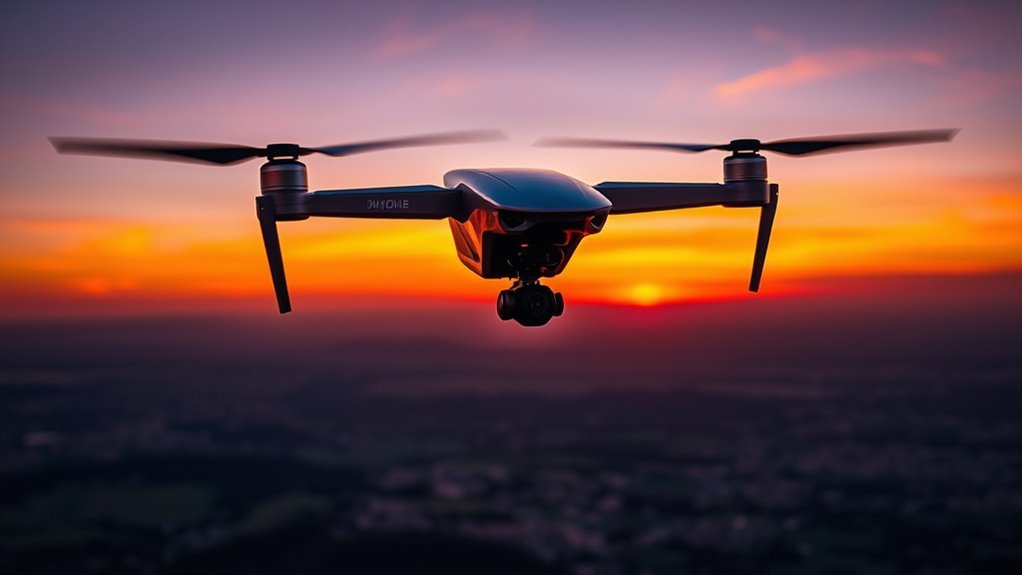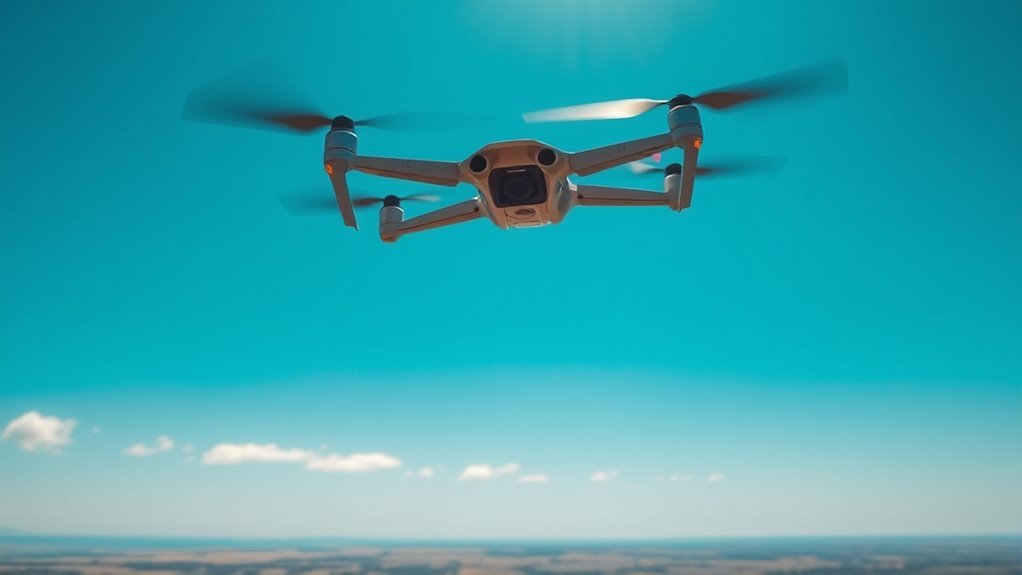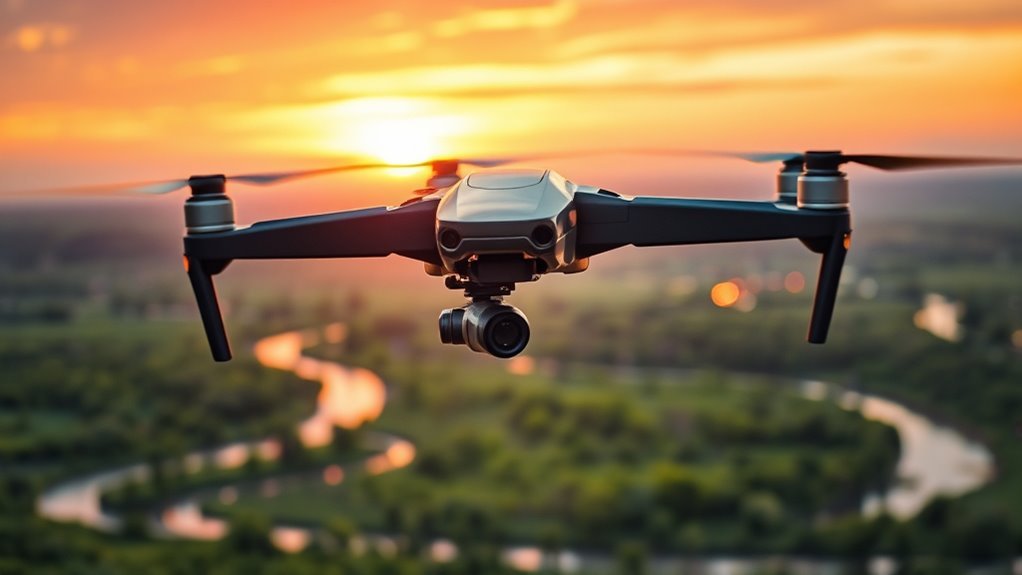To fly fast drones, you’ll need powerful, efficient motors paired with high-capacity, stable-voltage batteries to maximize thrust without wasting energy. Keeping your drone lightweight with carbon fiber frames and optimizing propeller size and blade pitch reduces drag. Aerodynamic shaping minimizes airflow resistance while flight controller settings and real-time data adjust responsiveness. Environmental factors like wind and temperature also impact speed, as does pilot skill for precise maneuvers. Understanding all these elements opens a fuller grasp of rapid drone flight.
Motor Power and Efficiency

Although several components influence a drone’s speed, motor power and efficiency play an essential role in determining its maximum velocity and acceleration. You need to understand that motor torque directly affects the drone’s thrust, enabling rapid acceleration and higher top speeds. However, maximizing torque alone isn’t enough; achieving an efficiency balance is vital to prevent energy losses that reduce flight time. When you optimize motor design, focusing on copper winding quality and magnetic material, you enhance torque output without compromising efficiency. This balance guarantees your drone delivers powerful thrust while maintaining energy conservation, granting you greater freedom to explore vast areas swiftly. By prioritizing motor power and efficiency, you tap into the drone’s full potential for speed without sacrificing operational endurance.
Battery Capacity and Voltage

When you increase battery capacity and voltage, you directly impact a drone’s flight duration and power output. Higher capacity batteries store more energy, enabling longer flights, while increased voltage provides greater motor torque and speed. However, the choice of battery chemistry types—such as LiPo, Li-ion, or LiFePO4—affects energy density, discharge rates, and weight, which in turn influence overall performance. You must also consider voltage regulation techniques to maintain stable power delivery and prevent damage to sensitive electronics. Efficient voltage regulation optimizes the balance between power output and thermal management, ensuring your drone operates at peak efficiency. Understanding these parameters allows you to maximize flight freedom without compromising reliability or control precision.
Drone Weight and Frame Material

A drone’s weight and frame material critically influence its speed, agility, and energy efficiency. You’ll want to select drone materials that offer a high strength-to-weight ratio—carbon fiber composites are ideal due to their stiffness and minimal mass. This reduces inertial drag, allowing quicker acceleration and sharper maneuvers. Equally important is optimizing weight distribution; uneven mass can destabilize flight dynamics and limit top speed. By centrally locating heavier components and minimizing peripheral weight, you improve balance and responsiveness. Lightweight frames also lessen power consumption, extending flight duration without sacrificing velocity. When you prioritize advanced drone materials and precise weight distribution, you reveal the drone’s full potential for rapid, controlled flight—granting you the freedom to push boundaries with confidence and efficiency.
Propeller Size and Design
Enhancing a drone’s weight and frame material sets the stage for maximizing propulsion efficiency, where propeller size and design play a defining role. You need to select propeller size carefully, as it directly influences thrust and drag balance. Propeller efficiency hinges on blade shape, pitch, and materials used, which affect responsiveness and durability. Consider these critical factors:
- Larger propellers generate more thrust but can increase drag, reducing top speed.
- Blade pitch determines the angle of attack, impacting acceleration and efficiency.
- Advanced propeller materials, like carbon fiber composites, reduce weight while enhancing stiffness.
- Blade count affects airflow; fewer blades can mean higher speed but less stability.
- Precision in propeller design minimizes energy loss, maximizing battery life and flight range.
Choosing ideal propeller size and materials will empower your drone to soar faster with greater control.
Aerodynamics and Body Shape
You need to focus on the streamlined frame design to minimize airflow resistance and improve speed. Understanding different wing configuration types will help you optimize lift-to-drag ratios for fast maneuvers. Additionally, employing effective drag reduction techniques is essential to maintain high velocity without compromising stability.
Streamlined Frame Design
Although aerodynamic efficiency often goes unnoticed, it plays a critical role in determining a drone’s maximum speed and stability. When you focus on streamlined frame design, you minimize drag, allowing your drone to slice through the air with less resistance. Key factors in design optimization include selecting advanced frame materials and shaping the body to reduce turbulent airflow.
To enhance your drone’s performance, consider these elements:
- Use lightweight, rigid frame materials like carbon fiber
- Employ smooth, contoured surfaces to lower drag coefficients
- Integrate compact, aerodynamic motor mounts
- Minimize protrusions that disrupt airflow
- Optimize component placement to maintain a balanced center of gravity
Wing Configuration Types
When selecting a wing configuration for your drone, understanding how different shapes influence aerodynamic efficiency and stability is essential. Various wing types—such as straight, swept, delta, and elliptical—offer distinct configuration benefits tailored to speed and maneuverability. Swept wings reduce drag at high velocities, enhancing your drone’s top speed, while delta wings provide structural strength and stability during rapid turns. Straight wings, though simpler, balance lift and control for moderate speeds. Elliptical wings optimize lift distribution, reducing induced drag and improving energy efficiency. By analyzing these wing types, you can select a configuration that maximizes aerodynamic performance without compromising control. Choosing the right wing configuration ultimately empowers you to push your drone’s limits, achieving the freedom to fly faster while maintaining precise handling.
Drag Reduction Techniques
Since aerodynamic drag directly limits a drone’s maximum speed and efficiency, minimizing it through targeted design strategies is essential. You’ll want to focus on reducing drag coefficients by optimizing the drone’s shape and selecting appropriate surface materials. Here are key drag reduction techniques to contemplate:
- Streamline body contours to promote laminar airflow and reduce turbulence.
- Use low-friction, smooth surface materials to minimize skin friction drag.
- Incorporate retractable components to avoid protrusions that increase drag.
- Apply specialized coatings that repel dust and moisture, preserving aerodynamic integrity.
- Design compact airframes with minimal frontal area to lower pressure drag.
Flight Controller and Software Optimization
A drone’s flight controller serves as its central processing unit, managing sensor data, motor outputs, and stabilization algorithms to guarantee peak performance. When you’re aiming for maximum speed, optimizing this core system becomes essential. Advanced software algorithms process inputs with minimal latency, refining flight stability even at extreme velocities. You’ll want a controller that dynamically adjusts motor thrust and compensates for rapid directional changes, ensuring agile responsiveness without sacrificing control. Efficient algorithmic tuning reduces oscillations and enhances predictive corrections, allowing you to push the drone’s limits confidently. By prioritizing software optimization alongside hardware, you reveal smoother, faster flight paths and a more intuitive piloting experience, giving you the freedom to explore high-speed flight with precision and reliability.
Environmental Factors Affecting Speed
You need to contemplate how wind conditions can either impede or enhance your drone’s speed by affecting its stability and drag. Temperature variations also influence air density, which directly impacts lift and propulsion efficiency. Understanding these environmental factors is essential for optimizing your drone’s performance in real-world conditions.
Wind Impact
Although drones are engineered for speed and agility, wind conditions can considerably alter their performance by introducing unpredictable forces. You’ll find wind resistance directly opposes your drone’s thrust, reducing maximum velocity. Turbulence effects cause erratic movements that force the flight controller to constantly adjust, compromising speed and stability. To optimize flight in windy conditions, consider these factors:
- Wind direction relative to flight path
- Gust intensity and frequency
- Drone aerodynamic profile
- Control system responsiveness
- Real-time wind data integration
Temperature Effects
When temperatures fluctuate, they greatly influence your drone’s motor efficiency and battery output, directly affecting speed. Efficient temperature regulation is critical; excessive heat can degrade battery performance and reduce motor torque, while cold conditions increase internal resistance, limiting power delivery. Understanding thermal dynamics helps you anticipate these effects and enhance flight parameters accordingly. Your drone’s cooling system must dissipate heat effectively to maintain peak performance during high-speed maneuvers. Conversely, in low temperatures, pre-flight warming routines guarantee batteries operate within ideal voltage ranges, preventing unexpected power drops. By mastering these thermal dynamics, you preserve motor integrity and battery capacity, enabling sustained high velocity. Ultimately, controlling temperature effects empowers you to reveal your drone’s full speed potential, granting the freedom to push boundaries without compromising reliability.
Pilot Skill and Flight Mode Settings
Since pilot skill directly influences a drone’s responsiveness and stability, understanding flight mode settings becomes essential for maximizing speed performance. With advanced pilot training and refined control techniques, you can exploit your drone’s full velocity potential while maintaining precision. Flight modes tailor the drone’s behavior—from beginner-friendly stabilization to aggressive acro modes—impacting acceleration and maneuverability. Mastering these settings lets you push limits without sacrificing control.
Key factors to focus on include:
- Selecting appropriate flight modes based on skill level
- Fine-tuning sensitivity and responsiveness parameters
- Practicing precise throttle and yaw control techniques
- Understanding aerodynamic effects at high speeds
- Continuous pilot training to adapt to dynamic flight conditions

